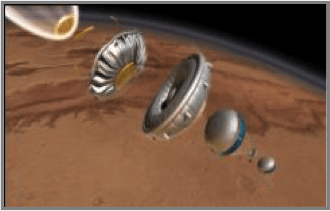Landing large payloads on Mars — large enough to bring humans to the Red Planet’s surface — is still beyond our capability. “There’s too much atmosphere on Mars to land heavy vehicles like we do on the moon, using propulsive technology completely,” said Rob Manning, Chief Engineer for the Mars Exploration Directorate, in an article we wrote a few years ago about the problems of landing on Mars “and there’s too little atmosphere to land like we do on Earth. Mars atmosphere provides an ugly, grey zone.”
The best hope on the horizon for making the human missions to Mars possible are supersonic decelerators that are now being developed. This new technology will hopefully be able to slow larger, heavier landers from the supersonic speeds of atmospheric entry to subsonic ground-approach speeds. NASA’s Low Density Supersonic Decelerator (LDSD) program is testing out some of these new devices and recently performed a trial run on a rocket sled test to replicate the forces a supersonic spacecraft would experience prior to landing. The sled tests will see how inflatable and parachute decelerators work to slow spacecraft prior to landing and allow NASA to increase landed payload masses, as well as improve landing accuracy and increase the altitude of safe landing-sites.
[/caption]
Three devices are being developed: two different sizes of supersonic inflatable aerodynamic decelerators and super-huge parachutes. The supersonic inflatable decelerators are very large, durable, balloon-like pressure vessels that inflate around the entry vehicle and slow it from Mach 3.5 or greater to Mach 2. These decelerators are being developed in 6-meter-diameter and 9-meter-diameters.
The large parachute is 30 meters in diameter, and it will further slow the entry vehicle from Mach 2 to subsonic speeds. All three devices will be the largest of their kind ever flown at speeds several times greater than the speed of sound.
Together, these new drag devices can increase payload delivery to the surface of Mars from our current capability of 1.5 metric tons to 2 to 3 metric tons, depending on which inflatable decelerator is used in combination with the parachute. They will increase available landing altitudes by 2-3 kilometers, increasing the accessible surface area we can explore. They also will improve landing accuracy from a margin of 10 kilometers to just 3 kilometers. All these factors will increase the capabilities and robustness of robotic and human explorers on Mars.
NASA is now testing these devices on rocket sleds and later will conduct tests high in Earth’s stratosphere, simulating entry into Mars’ thin atmosphere. The first supersonic flight tests are set for 2013 and 2014.

